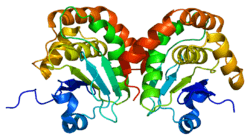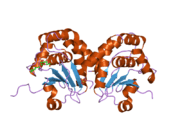DUSP15
Dual specificity protein phosphatase 15 is an enzyme that in humans is encoded by the DUSP15 gene.[5][6]
The protein encoded by this gene belongs to the non-receptor class of the protein-tyrosine phosphatase family. The encoded protein has both protein-tyrosine phophatase activity and serine/threonine-specific phosphatase activity, and therefore is known as a dual specificity phosphatase. Three transcript variants, encoding two different isoforms have been found for this gene.[6]
References
- 1 2 3 GRCh38: Ensembl release 89: ENSG00000149599 - Ensembl, May 2017
- 1 2 3 GRCm38: Ensembl release 89: ENSMUSG00000042662 - Ensembl, May 2017
- ↑ "Human PubMed Reference:".
- ↑ "Mouse PubMed Reference:".
- ↑ Alonso A, Narisawa S, Bogetz J, Tautz L, Hadzic R, Huynh H, Williams S, Gjorloff-Wingren A, Bremer MC, Holsinger LJ, Millan JL, Mustelin T (Jul 2004). "VHY, a novel myristoylated testis-restricted dual specificity protein phosphatase related to VHX". J Biol Chem. 279 (31): 32586–91. doi:10.1074/jbc.M403442200. PMID 15138252.
- 1 2 "Entrez Gene: DUSP15 dual specificity phosphatase 15".
Further reading
- Yoon TS, Jeong DG, Kim JH, et al. (2006). "Crystal structure of the catalytic domain of human VHY, a dual-specificity protein phosphatase". Proteins. 61 (3): 694–7. doi:10.1002/prot.20642. PMID 16170801.
- Gerhard DS, Wagner L, Feingold EA, et al. (2004). "The status, quality, and expansion of the NIH full-length cDNA project: the Mammalian Gene Collection (MGC)". Genome Res. 14 (10B): 2121–7. doi:10.1101/gr.2596504. PMC 528928. PMID 15489334.
- Ota T, Suzuki Y, Nishikawa T, et al. (2004). "Complete sequencing and characterization of 21,243 full-length human cDNAs". Nat. Genet. 36 (1): 40–5. doi:10.1038/ng1285. PMID 14702039.
- Strausberg RL, Feingold EA, Grouse LH, et al. (2003). "Generation and initial analysis of more than 15,000 full-length human and mouse cDNA sequences". Proc. Natl. Acad. Sci. U.S.A. 99 (26): 16899–903. doi:10.1073/pnas.242603899. PMC 139241. PMID 12477932.
- Deloukas P, Matthews LH, Ashurst J, et al. (2002). "The DNA sequence and comparative analysis of human chromosome 20". Nature. 414 (6866): 865–71. doi:10.1038/414865a. PMID 11780052.
- Dias Neto E, Correa RG, Verjovski-Almeida S, et al. (2000). "Shotgun sequencing of the human transcriptome with ORF expressed sequence tags". Proc. Natl. Acad. Sci. U.S.A. 97 (7): 3491–6. doi:10.1073/pnas.97.7.3491. PMC 16267. PMID 10737800.
This article is issued from
Wikipedia.
The text is licensed under Creative Commons - Attribution - Sharealike.
Additional terms may apply for the media files.





